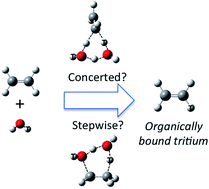Reaction mechanism of hydrogen-tritium exchange reactions between several organic and HTO molecules: a role of the second HTO
Abstract
The mechanism of hydrogen-tritium (H-T) exchange reactions between several small organic and HTO molecules have been investigated using M06-2X/6-311++G(d,p) method. The second HTO molecule is taken into account for both direct and addition–elimination H-T exchange reactions. The reactivity of small organic molecules for H-T exchange reactions is in the order of CH3COOH > CH3CH2OH > CH3CHO ≈ CH3COCH3 ≈ C2H4 and C3H6 > CH4, C2H6, and C3H8. In particular, the energies of activation in addition–elimination H-T exchange reactions of alkene with two HTO molecules become lower than those of direct H-T exchange ones. Our study reveals that (i) the reactivity of alkene with HTO molecules is comparable to that of aldehyde and ketone when the effect of the second HTO molecule is taken into account and (ii) the H-T exchange reactions between alkene and HTO molecules prefer addition–elimination H-T exchange mechanism, whereas other organic molecules favor a direct one.



 Please wait while we load your content...
Please wait while we load your content...